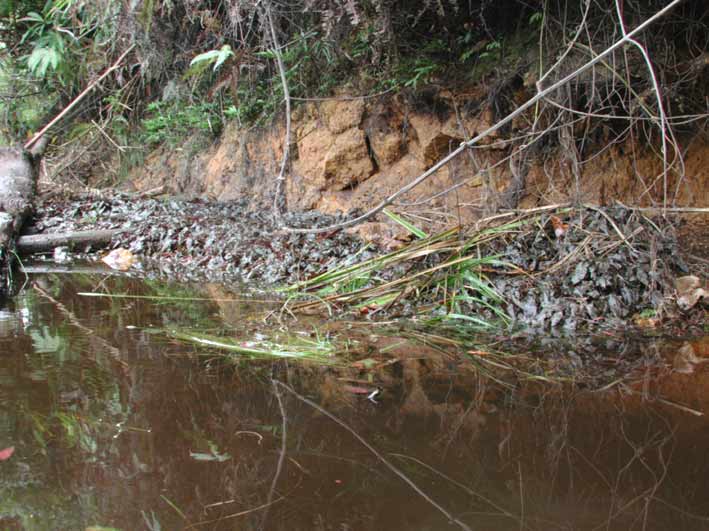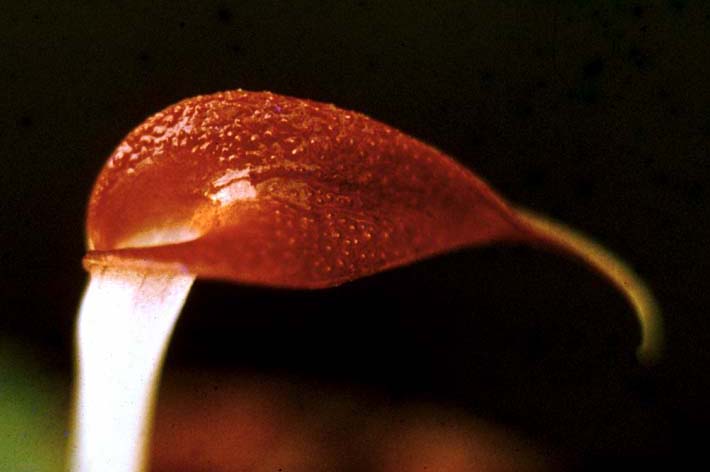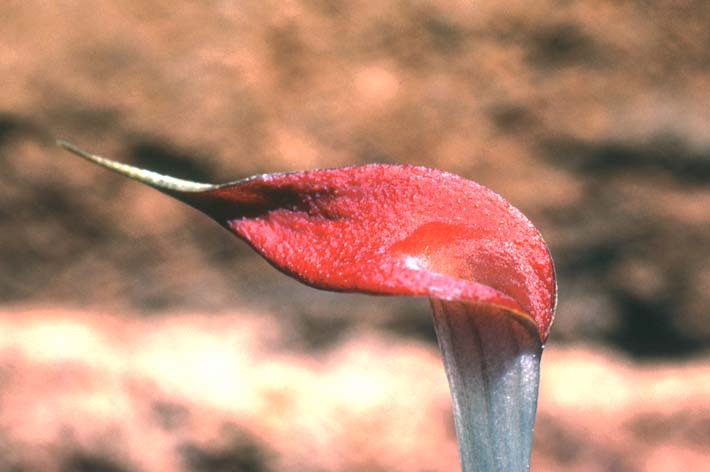 |
Brownish green, smooth to bullate leaves and a
striking red limb of the spatha.
coll. Sasaki I-SASL2 (=SP2)
photo Sasaki |
|
 |
The surface of the limb is rather rough and
there is a distinct collar.
coll. Sasaki I-SASL2 (=SP2)
photo Sasaki
|
|
 |
Locality where C. ×borneoensis is found. Note the low water level (clear banks).
coll. Sasaki SP2
photo Sasaki |
|
 |
Another picture of the locality near Sampit in
South Kalimantan.
coll. Sasaki SP2
photo Sasaki
|
|
| |
|
|
|
 |
Lower part of the tube (kettle) of C. ×borneoensis. The top of the
kettle is densely spotted with red dots.
coll. Sasaki SP2
photo Sasaki
|
|
 |
The upper part of the spadix with the male
flowers. Note the purple top (appendix), as also seen in C.
grabowskii.
coll. Sasaki SP2
photo Sasaki |
|
 |
Another collection of C. ×borneoensis.
coll. Sasaki SP3a
photo Sasaki
|
|
 |
Probably, this plant must be regarded as another
hybrid, also growing in South Kalimantan.
coll. Sasaki I-SAKK1
photo Sasaki
|
|
| |
|
|
|
 |
The plant from the Malay peninsula C. ×purpurea may also have a rough
surface of the limb, but does not have a collar.
coll. hort., cult. M
photo Möhlmann
|
|
 |
C. ×purpurea with a smooth surface of the limb.
coll. hort. cult. B14
|
|
 |
C. grabowskii from
the region near Sampit. The limb is very dark.
coll. Idei B-03
photo Sasaki
|
|
 |
Distribution of C. × borneoensis. Probably the hybrid is more widespread in Kalimantan.
|
|
| |
|
|
|
The occurrence of C. ×purpurea like
plants from Kalimantan is known from 1975 when P.M. Driessen writes in a letter to Prof.
de Wit in Wageningen that he found a 'purpurea-like' plant near Tamiang Layang. He also
shipped plants, but no results are mentioned by De Wit. It was not until Mr. Sasaki from
Japan from 1999 did intensive research in the whole area, collecting Cryptocoryne.
Of much importance is in this case that he also collected C. griffithii (not
documented with plants from Kalimantan before) and C. zonata (very common in
Kalimantan). The most exiting result was that he collected all three plants in one
stream! The Kalimantan plant differs from the plants from the Malay peninsula in
having a a pronounced collar, a more or less purple zone in the upper part of the kettle
and a purple colored appendix of the spadix. The surface of the limb of the spathe is
rather rough, but this is also known for some Malay plants. As known for C. ×purpurea from W. Malaysia, this plant is regarded as a hybrid
between C. griffithii and C. cordata var. cordata
(Jacobsen 1982) because of the defect pollen and the fact that never fruits were
observed. The Kalimantan plants also do have defect pollen. The chromosome number for
the Kalimantan plant turns out to be 2n=51. The parents of C. × borneoensis will be C. griffithii (2n=34) and C. grabowskii (2n=68).
C. ´borneoensis is rather easy in cultivation and may be useful for the aquarium.
Note. The '×' without blank between the epithet, indicates the
hybrid status according to the International Code of Botanical Nomenclature, as do the use
of the word 'nothovar.' for hybrid plant varieties.
Updated January 2003 |
Literature :
- Jacobsen, N. 2002. Der Cryptocoryne cordata Griffith -
Komplex (Araceae) in Malesien. Aqua-Planta 27 : 150-151.
- Jacobsen, N., J.D. Bastmeijer & Y. Sasaki, 2002. Cryptocoryne ×purpurea Ridley nothovar. borneoensis N. Jacobsen,
Bastmeijer & Y. Sasaki (Araceae), eine neue Hybridvarietät aus Kalimantan.
Aqua-Planta 27 : 152-154. (Document service)
|
|